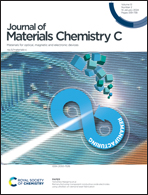Spontaneous formation of liquid-crystalline nuclei in blue-phase liquid crystals based on different chirality†
Abstract
The self-assembly of three-dimensional nanostructures of blue-phase liquid crystals is becoming the spotlight of soft matter research and has potential applications in photonic crystals, sensors, electro-optic devices, and others. However, studies on phase transitions—isotropic phase to blue phases, where chirality is of fundamental importance—are limited. Such studies provide insight into the formation of blue-phase liquid crystalline nuclei and the growth of soft crystals. Herein, we controlled the chirality values in blue-phase liquid crystals to observe the liquid crystalline nuclei occurring from the isotropic phase with different lattice planes. Three different lattice planes, namely BPI (011), BPII (011), and BPII (001), are achieved through uniform parallel anchoring by controlling the chirality of blue-phase liquid crystals. The specific lattice plane of BPII (011) appears around the chirality where the phase transition changed from Iso-BPI to Iso-BPII, and the lattice constants of the blue phases in this chiral range are in dynamic equilibrium. The same phenomena are observed in two different liquid crystal hosts of HTG135200-100 and 5CB. The revealed spontaneous mechanism of nucleus formation provides insight into the nanostructures of blue phases and the ability to tune lattice orientations of the blue-phase soft crystals.



 Please wait while we load your content...
Please wait while we load your content...